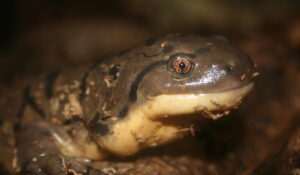Salamanders are fascinating little amphibians with smooth skin and secretive habits. One of the strangest things you might notice if you watch them closely is how they lick their own eyes. It can look odd at first, why would a salamander stick out its tongue and swipe across its eyeballs?
Salamanders lick their eyes to keep them moist and clean. Since they don’t have eyelids, this is the only way they can protect their eyes from drying out or getting dirty.
This behavior might look unusual to us, but for salamanders, it’s an everyday habit that keeps their vision sharp and their eyes safe.
Salamanders Don’t Have Eyelids
One of the main reasons salamanders lick their eyes is because they don’t have eyelids. Unlike mammals, they can’t blink or close their eyes.

This means their eyes are always exposed to the air, water, and anything floating around.
To deal with this, salamanders use their tongues as a replacement. Each lick spreads a layer of moisture across the eye, keeping it from drying out.
At the same time, that swipe of the tongue can brush away any dust or tiny bits of debris stuck to the eye’s surface.
Since salamanders rely heavily on their vision to find food and avoid predators, keeping their eyes clean and moist is very important.
Moisture Keeps Salamanders’ Eyes Healthy
Salamanders usually live in damp places like forests, streams, and wetlands. But sometimes they end up in drier conditions where moisture evaporates quickly. When this happens, their eyes can dry out if they don’t keep licking them.
Moisture on the eye is what keeps it smooth and working properly. Without it, salamanders would feel irritation and even risk losing part of their sight.
Their saliva helps fix this problem by coating the eyes with water and natural enzymes that add protection.
The tongue is sticky, which makes it perfect for spreading that thin layer of moisture evenly across the eye. That little action can mean the difference between healthy eyes and painful dryness.
Licking Removes Dirt and Debris
Salamanders spend a lot of time moving through leaf litter, soil, and water plants. All of these places are full of tiny particles (dust, dirt, and bits of organic matter) that can easily get into their eyes.
When a salamander licks its eyes, the tongue works like a gentle wipe, sweeping away anything that doesn’t belong there.

This keeps the eye surface clear and reduces the chances of irritation, scratches, or infections.
Clear eyes mean better vision, which salamanders need to avoid danger and hunt for food. A dirty or irritated eye could easily put them at risk.
Salamanders Aren’t the Only Ones Who Do This
Salamanders aren’t alone when it comes to eye-licking. Other amphibians, like frogs and toads, also use unique ways to keep their eyes moist and clean.
For example, some frogs actually push their eyes down into their mouths when they swallow, which helps clean and protect the eyes.
Salamanders take a simpler approach, they just lick them.
These behaviors are great examples of how amphibians adapt to their unusual anatomy and environments.
How Often Do Salamanders Lick Their Eyes?
How often a salamander licks its eyes depends on where it is. In a wet, humid environment, they don’t need to do it as often.
But in drier, dustier places, they’ll lick their eyes more frequently.
Researchers and pet owners who watch salamanders have noticed that they do this regularly throughout the day.
It’s automatic and instinctive, just like how you blink without thinking about it.
Is Eye-Licking Safe?
Yes, licking their eyes is completely safe and natural for salamanders. Their saliva even has some antimicrobial properties, which means it can help defend against harmful bacteria or fungi.

The only time it becomes risky is if the salamander lives in a polluted environment. If chemicals or toxins are on their skin, those can end up on the tongue and then spread onto the eyes.
That’s one reason why clean, healthy habitats are so important for salamanders.
What This Behavior Tells Us About Salamanders
This simple eye-licking behavior actually says a lot about how salamanders survive. Even though they don’t have eyelids, they’ve developed their own way of keeping their eyes moist and protected.
It’s a great example of how animals adapt to fit their needs, using behaviors instead of body parts they don’t have.
For salamanders, licking their eyes is just as natural and necessary as breathing.
How You Can Help Salamanders
If you ever handle salamanders, always wash your hands first. That way, you don’t transfer chemicals, dirt, or oils that could end up in their eyes.
Even more importantly, helping keep their natural homes clean and safe makes a big difference. Salamanders need moist, shaded places with clean water to stay healthy.
By protecting these environments, you give them the chance to live naturally and carry on their unique behaviors, like eye-licking, without harm.
Conclusion
Salamanders lick their eyes because they don’t have eyelids. This simple behavior keeps their eyes moist, clears away dirt, and protects them from irritation or damage.
What looks like an odd little habit is actually a very important survival tool. By understanding and respecting this behavior, we can better appreciate salamanders and the delicate balance they keep in their environments.
Protecting their habitats and keeping them safe allows these fascinating creatures to thrive with clear, healthy eyes for years to come.
Hi, my name is Ezra Mushala, i have been interested animals all my life. I am the main author and editor here at snakeinformer.com.

